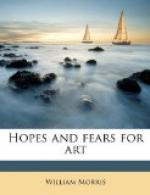Red is also a difficult colour to use, unless it be helped by some beauty of material, for, whether it tend toward yellow and be called scarlet, or towards blue and be crimson, there is but little pleasure in it, unless it be deep and full. If the scarlet pass a certain degree of impurity it falls into the hot brown-red, very disagreeable in large masses. If the crimson be much reduced it tends towards a cold colour called in these latter days magenta, impossible for an artist to use either by itself or in combination. The finest tint of red is a central one between crimson and scarlet, and is a very powerful colour indeed, but scarce to be got in a flat tint. A crimson broken by greyish-brown, and tending towards russet, is also a very useful colour, but, like all the finest reds, is rather a dyer’s colour than a house-painter’s; the world being very rich in soluble reds, which of course are not the most enduring of pigments, though very fast as soluble colours.
Pink, though one of the most beautiful colours in combination, is not easy to use as a flat tint even over moderate spaces; the more orangy shades of it are the most useful, a cold pink being a colour much to be avoided.
As to purple, no one in his senses would think of using it bright in masses. In combination it may be used somewhat bright, if it be warm and tend towards red; but the best and most characteristic shade of purple is nowise bright, but tends towards russet. Egyptian porphyry, especially when contrasted with orange, as in the pavement of St. Mark’s at Venice, will represent the colour for you. At the British Museum, and one or two other famous libraries, are still left specimens of this tint, as Byzantine art in its palmy days understood it. These are books written with gold and silver on vellum stained purple, probably with the now lost murex or fish-dye of the ancients, the tint of which dye-stuff Pliny describes minutely and accurately in his ‘Natural History.’ I need scarcely say that no ordinary flat tint could reproduce this most splendid of colours.
Though green (at all events in England) is the colour widest used by Nature, yet there is not so much bright green used by her as many people seem to think; the most of it being used for a week or two in spring, when the leafage is small, and blended with the greys and other negative colours of the twigs; when ’leaves grow large and long,’ as the ballad has it, they also grow grey. I believe it has been noted by Mr. Ruskin, and it certainly seems true, that the pleasure we take in the young spring foliage comes largely from its tenderness of tone rather than its brightness of hue. Anyhow, you may be sure that if we try to outdo Nature’s green tints on our walls we shall fail, and make ourselves uncomfortable to boot. We must, in short, be very careful of bright greens, and seldom, if ever, use them at once bright and strong.
On the other hand, do not fall into the trap of a dingy bilious-looking yellow-green, a colour to which I have a special and personal hatred, because (if you will excuse my mentioning personal matters) I have been supposed to have somewhat brought it into vogue. I assure you I am not really responsible for it.




